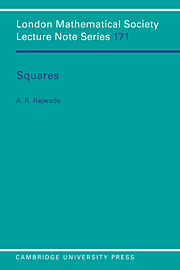Book contents
- Frontmatter
- Contents
- Preface
- Notation
- Chapter 1 The theorem of Hurwitz (1898) on the 2, 4, 8-identities
- Chapter 2 The 2n-identities and the Stufe of fields: theorems of Pfister and Cassels
- Chapter 3 Examples of the Stufe of fields and related topics
- Chapter 4 Hilberts 17th problem and the function fields ℝ(X), ℚ(X) and ℝ(X, Y)
- Chapter 5 Positive semi-definite functions and sums of squares in ℝ(X1X2, … Xn)
- Chapter 6 Introduction to Hilbert's theorem (1888) in the ring ℝ[X1, X2, … Xn]
- Chapter 7 The two proofs of Hilbert's main theorem; Hilbert's own and the other of Choi and Lam.
- Chapter 8 Theorems of Reznick and of Choi, Lam and Reznick
- Chapter 9 Theorems of Choi, Calderon and of Robinson
- Chapter 10 The Radon function and the theorem of Hurwitz-Radon (1922–23)
- Chapter 11 Introduction to the theory of quadratic forms
- Chapter 12 Theory of multiplicative forms and of Pfister forms
- Chapter 13 The rational admissibility of the triple (r, s, n) and the Hopf condition
- Chapter 14 Some interesting examples of bilinear identities and a theorem of Gabel
- Chapter 15 Artin-Schreier theory of formally real fields
- Chapter 16 Squares and sums of squares in fields and their extension fields
- Chapter 17 Pourchet's theorem that P(Q(x)) = 5 and related results
- Chapter 18 Examples of the Stufe and pythagoras number of fields using the Hasse-Minkowski theorem
- Appendix 1 Reduction of matrices to canonical forms (for Chapter 10)
- Appendix 2 Convex sets (for chapters 6, 7, 8, 9)
- References
- Index
Chapter 4 - Hilberts 17th problem and the function fields ℝ(X), ℚ(X) and ℝ(X, Y)
Published online by Cambridge University Press: 27 October 2009
- Frontmatter
- Contents
- Preface
- Notation
- Chapter 1 The theorem of Hurwitz (1898) on the 2, 4, 8-identities
- Chapter 2 The 2n-identities and the Stufe of fields: theorems of Pfister and Cassels
- Chapter 3 Examples of the Stufe of fields and related topics
- Chapter 4 Hilberts 17th problem and the function fields ℝ(X), ℚ(X) and ℝ(X, Y)
- Chapter 5 Positive semi-definite functions and sums of squares in ℝ(X1X2, … Xn)
- Chapter 6 Introduction to Hilbert's theorem (1888) in the ring ℝ[X1, X2, … Xn]
- Chapter 7 The two proofs of Hilbert's main theorem; Hilbert's own and the other of Choi and Lam.
- Chapter 8 Theorems of Reznick and of Choi, Lam and Reznick
- Chapter 9 Theorems of Choi, Calderon and of Robinson
- Chapter 10 The Radon function and the theorem of Hurwitz-Radon (1922–23)
- Chapter 11 Introduction to the theory of quadratic forms
- Chapter 12 Theory of multiplicative forms and of Pfister forms
- Chapter 13 The rational admissibility of the triple (r, s, n) and the Hopf condition
- Chapter 14 Some interesting examples of bilinear identities and a theorem of Gabel
- Chapter 15 Artin-Schreier theory of formally real fields
- Chapter 16 Squares and sums of squares in fields and their extension fields
- Chapter 17 Pourchet's theorem that P(Q(x)) = 5 and related results
- Chapter 18 Examples of the Stufe and pythagoras number of fields using the Hasse-Minkowski theorem
- Appendix 1 Reduction of matrices to canonical forms (for Chapter 10)
- Appendix 2 Convex sets (for chapters 6, 7, 8, 9)
- References
- Index
Summary
In 1900, David Hilbert [H4]′ in his famous address at the International Conress of Mathematicians in Paris proposed as his 17th problem the following:
Hilbert's conjecture. Let f(X1, …, Xn) ∈ R(X1, …, Xn). A necessary and sufficient condition that f is a sum of squares in R(X1, …, Xn) is that f is positive definite (i.e. f(a1, …, an) 0 for all a1, …, an ∈ R for which f is defined).
A similar conjecture holds for Q(X1, …, Xn). These conjectures were proved by Artin [A6] in 1927 for both R and Q, but one still didn't know how many squares are needed for the representation. Some results were of course known when the number of variables n = 1 or 2. Let us first look at the field R.
In R(X) two squares suffice:
Theorem 4.1. Let f(X) ∈ R(X) be positive definite; then f(X) is a sum of two squares.
This had already been proved by Hilbert in 1893, as also was the next result.
Theorem 4.2 (Hilbert (1893)). Let f(X, Y) ∈ R(X, Y) be positive definite; then f(X, Y) is a sum of four squares.
This was first proved by Hilbert [H4] and later again by Witt. We shall give a proof due to Pfister [P5]. This proof has the advantage that it can be generalized to the case of n variables.
In 1966, James Ax (unpublished) proved that in R(X, Y, Z) eight squares suffice. This has now been proved by Pfister in a very elegant way (see Chapter 5).
- Type
- Chapter
- Information
- Squares , pp. 46 - 59Publisher: Cambridge University PressPrint publication year: 1993



